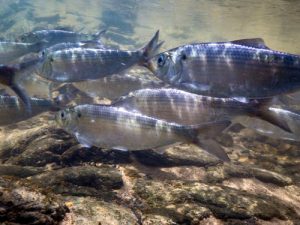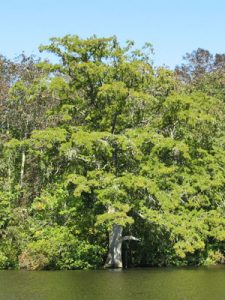
In North America’s Atlantic region, coastal rivers vary widely based on water flow, salinity and tidal influences. Depending on local geography, the convergence of freshwater creeks and rivers into saltwater estuaries might occur over a very short distance or pass through hundreds of miles of coldwater streams, creeks, swamps, rivers, salt marshes, and other environments.
Many of the best known Atlantic rivers begin life as small mountain streams which are fed by spring snow melts. From these seasonal drainages, water moves downstream, merging into continuously flowing cold water streams. Streams combine as they run towards the ocean, becoming larger creeks which eventually combine to form rivers.
As creeks and rivers move closer to the ocean, the land becomes flatter and currents slow considerably. Here water levels sometimes rise due to extreme high tides, but the flow on the surface is always downstream. Some of these areas are suitable spawning habitats for American shad, hickory shad, and river herring. Water visibility in these areas varies depending on location, rainfall and other factors.

As rivers and creeks move thru forested areas and water flow slows even more, spatterdock, cypress trees, and other swamp plants begin appearing in greater numbers.
Freshwater species of fish become abundant in these areas, including largemouth bass, chain pickerel, sunfish, crappie, catfish, shiners, white perch, yellow perch, gar, carp, and others. In some remote waterways, beavers and river otters are present.
As rivers reach their final few miles, pickerelweed and scattered patches of trees begin to give way to marsh grasses, sandy beaches and mud flats. Salinity in these mixing regions can fluctuate considerably, depending on rainfall, tidal flows, and other factors.
Brackish species of fish begin to disappear such as channel catfish, white perch, yellow perch and gar, giving way to saltwater fish. In salt marshes, crabs, oysters, mussels, and other shellfish are often present. Birds are abundant in salt marsh areas, with ospreys, kingfishers, herons, egrets, plovers, and rails being commonly seen.
Important Rivers of the Atlantic Region
The Hudson River flows from north to south through eastern New York over a course of 315 miles. It originates in the Adirondack Mountains, flows past Albany, and finally forms the border between New York City and New Jersey before emptying into Upper New York Bay. The lower half of the Hudson is tidal.
The Delaware River is the longest un-dammed river in the United States east of the Mississippi. The river extends 330 miles from the confluence of its east and west branches in New York to the mouth of the Delaware Bay where it meets the Atlantic Ocean. The river is fed by 216 tributaries which drain parts of Pennsylvania, New Jersey, New York, and Delaware.
Perhaps the most famous Atlantic waterway is the Susquehanna River. Traveling over 400 miles, it is the longest river in the USA Atlantic region. The Susquehanna forms from two main branches. The North Branch originates in upstate New York before merging with the shorter West Branch.
The river drains 27,500 square miles, including parts of Pennsylvania, New York, and Maryland. Scientists estimate that the Susquehanna transports more fresh water into the Chesapeake Bay than all other rivers combined.
Near the river’s entrance into the Chesapeake Bay, the Susquehanna Flats provides vital spawning habitat for American shad, hickory shad, striped bass, and other species of fish.
The Potomac River is the fourth largest river of the U.S. Atlantic Coast, passing through states and the District of Columbia. The river originates from two sources. The source of the North Branch begins in West Virginia and the South Branch begins in Highland County, Virginia. The Potomac River attains a width of roughly 11 statute miles between Point Lookout, Maryland and Smith Point.